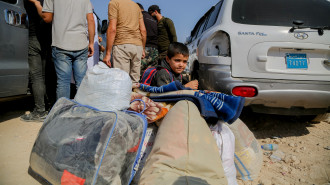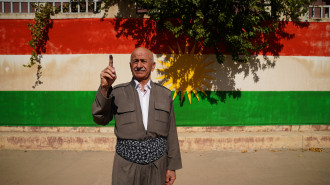East Aleppo flat evictions: A new ploy for ethnic cleansing?
Authorities in the battle-scarred Syrian city announced plans to evict residents from 10,000 buildings after a block of flats - damaged from bombing - collapsed over the weekend. They claimed that there had also been damage from lack of maintenance of sewage and water systems.
Aleppo's city council announced the decision on Sunday to expel four thousand families after the deadly collapse of a five-storey block in the formerly rebel-held neighbourhood of Salaheddin.
The tragic incident killed at least 11 people, including four children.
Aleppo's governor told pro-regime newspaper Al-Watan that the evicted people would be provided with temporary homes until the war-damaged buildings are renovated or re-built.
"An illegal evacuation decision requires approval from relevant authorities but people's lives are at stake," Hussein Diab was quoted as saying.
However civil engineer Mohammed Sari al-Seyed Ali told The New Arab that the collapse due to water damage was highly unlikely. He added that the building was more likely heavily damaged by Syrian regime shelling, on top of the fact that the buildings were probably not built to safety specifications in the first place.
Residents fear that the collapse of the Salaheddin building will allow for the regime to expel more residents from their homes under the pretext of safety.
Twitter Post
|
They say people have been forced to vacate their homes without knowing if they will ever be able to return once the reconstruction has taken place. They fear the buildings will be taken over by real estate development companies for development into luxury housing, as has happened in South Damascus, Yarmouk camp and parts of Homs.
Many residents worry there is no talk of alternative housing being provided for them after evacuation.
Majid Halabi told The New Arab: "The regime claims the collapse of these buildings is because of violence committed by the opposition, however the whole world witnessed how the regime helicopters attacked the East Aleppo, and how Russian planes targeted these buildings."
Halabi added that even before the war, many construction firms violated safety regulations. "There was no one supervising the construction process, and they weren't interested in the safety or validity of the buildings."
Aleppo had been divided for four years, starting in the summer of 2012, between a government-held west and a rebel-held east.
In 2016, the Syrian regime launched a months' long offensive that eventually brought the whole city under government control.
Saleheddin was heavily bombed during the regime onslaught on rebel-held districts with support from Russian warplanes.
What little reconstruction there has been among the ruins has been carried out privately. The state has limited public works to the restoration of basic infrastructure.
Many activists accuse the regime of deliberately neglecting these neighbourhoods, by not removing the rubble or clearing water damage.
Many of the buildings around the block that caved in still bear the scars of the ferocious four-year battle for the country's second city, with several on the brink of collapse.
According to Syrian authorities, half of the remaining buildings in east Aleppo are at risk of collapse.
The conflict has killed more than 400,000 people and led millions to flee their homes since starting with the brutal repression on anti-government protests in 2011.
Washington has estimated the costs of rebuilding Syria's devastated housing and infrastructure at between $300 billion and $400 billion.
Follow us on Twitter: @The_NewArab

![Palestinians mourned the victims of an Israeli strike on Deir al-Balah [Getty]](/sites/default/files/styles/image_684x385/public/2024-11/GettyImages-2182362043.jpg?h=199d8c1f&itok=xSHZFbmc)


![The law could be enforced against teachers without prior notice [Getty]](/sites/default/files/styles/image_684x385/public/2178740715.jpeg?h=a5f2f23a&itok=hnqrCS4x)
 Follow the Middle East's top stories in English at The New Arab on Google News
Follow the Middle East's top stories in English at The New Arab on Google News


